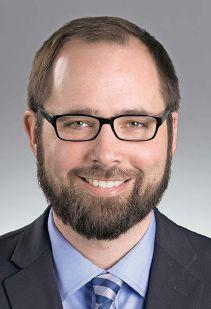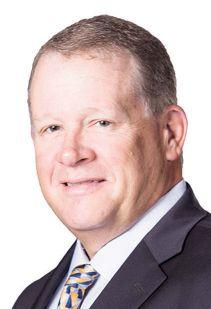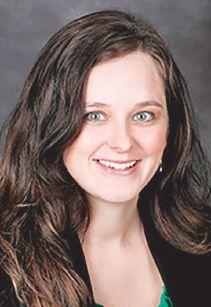
4 minute read
INSIGHTs & INTUITION Q.
How do you ensure your business is easily accessible and secure online? Have you done any recent website updates to optimize the experience for users?
Jon Hendry Chief Information Officer Alerus Financial Grand Forks, N.D.


Safety and security of information is extremely important, especially in the financial industry. At Alerus, we are always looking for new ways to provide a better client experience while also ensuring to safeguard important financial data accessed online by our clients. We recently introduced a new login experience with enhanced security features to keep up with this ever changing landscape and new, emerging security threats.
Additionally, we are launching new financial wellness tools in early September designed to help bring clients’ entire financial life into one, personalized hub. By partnering with leading FinTech companies, we’re excited to showcase new digital tools allowing clients the ability to automate their budget, link in outside financial accounts, and use their data to complete a series of short financial workouts to see how they’re doing with their finances.
At Sanford Health, we use tools to identify accessibility issues and look at our scores on a weekly basis to ensure we are at or above industry standards. In these weekly meetings, we determine the best course of action for making our site more accessible. Most changes are simple color swaps or changing call-to-action buttons to be more descriptive. Because some require deeper development work, we have an interactive designer and web developer sit in on these meetings to change code to become more accessible.
We recently revamped our entire website to create a better experience. We used many different types of data to inform our design and experience – web traffic analytics, mouse flows, heat maps and user recordings just to name a few. Since the launch, we have used tools to ensure the best user experience via identifying content gaps, rewriting content, fixing broken links and eliminating unnecessary content.
Matt Sage
Web Development Manager Sanford Health Sioux Falls, S.D.

Prior to May 2018, the University of North Dakota’s (UND) web presence was much like the Wild West – everyone did whatever they wanted with little oversight. The result: an unorganized and overloaded website that was not meeting accessibly standards.
A two-year website redevelopment project fixed the issues and new governance was implemented to ensure problems didn’t resurface.
A formal web policy was adopted that covers use of the content management system (CMS), brand guidelines and accessibility.
All CMS users were trained on accessibility, SEO, image quality, and navigation.
Approval workflows were introduced to the CMS, providing a final quality check.
We invested in a quality assurance software (Siteimprove) to flag issues that leak through the approval process.
We’re developing an annual audit process to make sure we’re still meeting essential standards.
Governance works. UND’s site is now half the size, serves prospective students first and is generating three times more inquiries.
Tara Buckley Director of Web & Multimedia Marketing Marketing & Creative Services UND Grand Forks, N.D.

Unemployment Rate
Exports Of Goods For North Dakota
All Employees: Total Nonfarm, commonly known as Total Nonfarm Payroll, is a measure of the number of U.S. workers in the economy that excludes proprietors, private household employees, unpaid volunteers, farm employees, and the unincorporated self-employed. This measure accounts for approximately 80 percent of the workers who contribute to Gross Domestic Product (GDP).
This measure provides useful insights into the current economic situation because it can represent the number of jobs added or lost in an economy. Increases in employment might indicate that businesses are hiring which might also suggest that businesses are growing. Additionally, those who are newly employed have increased their personal incomes, which means (all else constant) their disposable incomes have also increased, thus fostering further economic expansion.
Generally, the U.S. labor force and levels of employment and unemployment are subject to fluctuations due to seasonal changes in weather, major holidays, and the opening and closing of schools. The Bureau of Labor Statistics (BLS) adjusts the data to offset the seasonal effects to show non-seasonal changes: for example, women’s participation in the labor force; or a general decline in the number of employees, a possible indication of a downturn in the economy. To closely examine seasonal and non-seasonal changes, the BLS releases two monthly statistical measures: the seasonally adjusted All Employees: Total Nonfarm (PAYEMS) and All Employees: Total Nonfarm (PAYNSA), which is not seasonally adjusted.
Source: U.S. Bureau of Labor Statistics, All Employees: Total Nonfarm Payrolls [PAYEMS], retrieved from FRED, Federal Reserve Bank of St. Louis
Howie Milstein was being pulled in too many directions. It was time to do something about it by selling one of the two companies he operated. “We owned Active Therapeutics Institute and I was also President of a medical device company,” says Milstein, “I only had so much time and energy.”
“Crescenda opened up opportunities to sell ATI in a way we could never do ourselves,” says Milstein. “They identified the right buyers, kept advancing the ball and knew how to close the deal. Our goal was to preserve our culture and Crescenda found a buyer who did.”
”Jim Odney is the kind of person I want to do business with. He has a high level of integrity. He is intuitive, smart, creative and tenacious. He understands people and has a sense of humor. I won’t work with people who take themselves too seriously.”
For Milstein, the sale made life simpler, running the company he wanted to run, with more time for leisure. “I was free to focus more energy on the ‘day job’, and do volunteer work. I’m also finding a little more recreational time – like riding my motorcycle. Life is short. You don’t want to wait to do some of the things you want to do.”
Howie and Gail Milstein cruising the back roads











